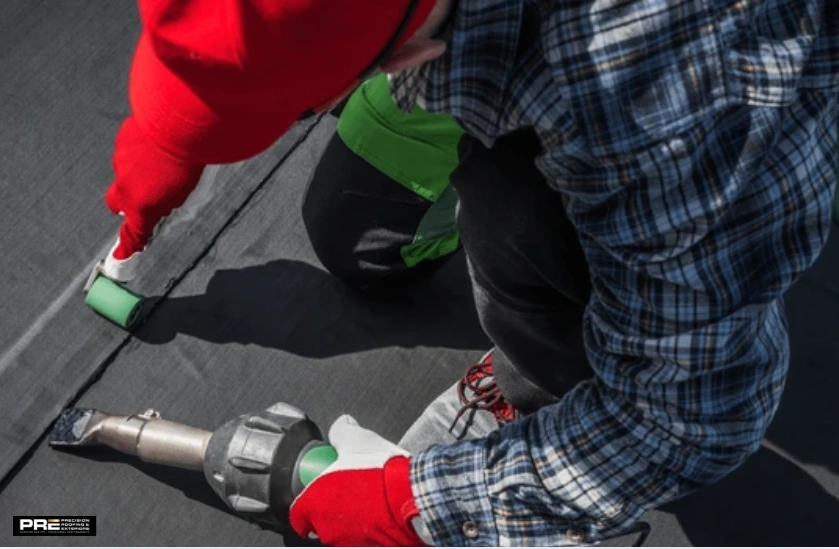EPDM roofing is known for its affordability, flexibility, and solid lifespan, making it a go-to choice for many flat or low-slope buildings. But just how long does an EPDM roof last? An EPDM roof can last between 25 and 50 years with proper installation and routine care.
That wide range depends on several key factors, including membrane thickness, installation method, exposure to environmental stress, and regular maintenance. Whether you’re considering EPDM for a commercial project or residential application, it’s important to understand the elements that influence its durability over time.
How Long Does an EPDM Roof Typically Last?
Most EPDM roofs last 25 to 30 years on average. However, when higher-quality membranes are used, especially thicker options like 60 mil or 90 mil, and they’re installed using a fully adhered system, the roof can push past the 40-year mark. Some reinforced EPDM systems have even been known to last up to 50 years under ideal conditions.
Unlike some materials, EPDM doesn’t become brittle with age and remains flexible across temperature extremes. That flexibility helps it resist cracking and UV degradation, two major issues with other flat-roof systems.
What Affects How Long an EPDM Roof Lasts?
Let’s walk through the core factors that determine the life expectancy of an EPDM roof.
Membrane Thickness and Reinforcement
EPDM is available in several thicknesses, typically 45 mil, 60 mil, and 90 mil. Thicker membranes naturally last longer because they offer better resistance to punctures, tears, and environmental wear.
Some reinforced EPDM systems also include scrim layers for added durability. While 45 mil might be sufficient for light-use roofs, choosing a thicker option extends the lifespan significantly, especially in areas exposed to frequent foot traffic or harsh weather.
Installation Method
How your EPDM roof is installed matters as much as the material itself. Fully adhered systems, where the membrane is glued to the substrate, tend to last longer than ballasted or mechanically fastened ones. This method reduces the risk of air pockets, uplift in high winds, and water intrusion.
Poor installation practices, such as weak seam sealing, poor flashing, or improper substrate preparation, can lead to early failure, regardless of the material’s quality.
Environmental Exposure
While EPDM holds up well under UV light and extreme temperatures, constant environmental pressure can shorten its lifespan. Prolonged exposure to standing water, intense heat, snow loads, or chemical pollutants can degrade the material over time.
Seams and edges may also experience stress in areas with frequent freeze-thaw cycles unless installed and sealed correctly. Dark EPDM membranes tend to absorb more heat, which can accelerate aging in warmer climates unless reflective coatings are applied.
Roof Design and Drainage
Because EPDM is often used on flat or low-slope roofs, drainage becomes critical in determining its lifespan. Poor drainage can lead to ponding water, which puts pressure on seams and speeds up material degradation.
A roof design with appropriate slope, tapered insulation, and well-maintained drains helps minimize water accumulation. EPDM roofs with efficient drainage systems experience fewer issues and longer service life.
Maintenance and Inspection
Routine maintenance plays a big role in getting the full lifespan out of your EPDM roof. Annual or biannual inspections help spot issues like seam separation, membrane shrinkage, punctures, or pooling water. Minor problems, if left unattended, can lead to major leaks or structural damage.
Clearing debris, checking flashing, and resealing joints when needed can extend the lifespan by many years. Proactive maintenance helps avoid expensive repairs and delays premature replacement.
Physical Impact and Roof Traffic
Flat roofs often double as spaces for HVAC equipment or walkways, which means EPDM membranes may endure foot traffic, dropped tools, or sharp debris. Thicker membranes and reinforced products can handle more physical stress, but all EPDM systems benefit from walkway pads or protection in high-traffic areas. Without protection, even minor punctures can lead to water infiltration and damage below the surface.
Conclusion
With the right maintenance, an EPDM roof can last 25 to 50 years, but that outcome depends on several factors working together. The membrane’s thickness, the quality of the installation, local climate conditions, drainage efficiency, physical wear, and regular upkeep all shape how well it holds up. When installed and maintained correctly, EPDM remains one of the most cost-effective and long-lasting options for flat and low-slope roofing.
For help selecting the best EPDM system for your building and ensuring proper EPDM roof installation from the start, reach out to the expert roofing contractors at Precision Roofing.

